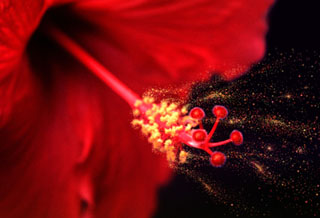Asexual Reproduction:
This is a nonsexual form of reproduction
in which an exact genetic copy of the parent is created. Examples
include budding, fragmentation, gemmae production, and stolon production.
| Picture of a gemmae cup. Some plants such as liverworts produce gemmae which are exact copies of the parent plant that produced them. These gemmae are held in cupules until rain water carry them away to a suitable location for growth. |
Sexual Reproduction:
Active Reproduction is assisted by animals.
A good example is seen with flowers and honey bees. As honey bees
go from flower to flower collecting nectar, they carry pollen with them.
This pollen is transferred from one flower to another, causing pollination.
Pollination is the first step in reproduction. The honey bee is an
example of an which is why it is an example of active reproduction.
|
This figure is showing a bee that is collecting nectar. Along with this nectar the bee will get some pollen which will likely fertilize another flower. |
Passive Reproduction is not assisted by animals.
Often instead the plant relies on the wind to carry pollen to reach and
pollinate the other plants. Lots of grasses use passive reproduction
and produce large amounts of wind blown pollen.
 |
This figure is showing how the pollen grains
from the Anther of one plant are carried passively by wind to the ovules
of another plant on the plants Stigma.
|